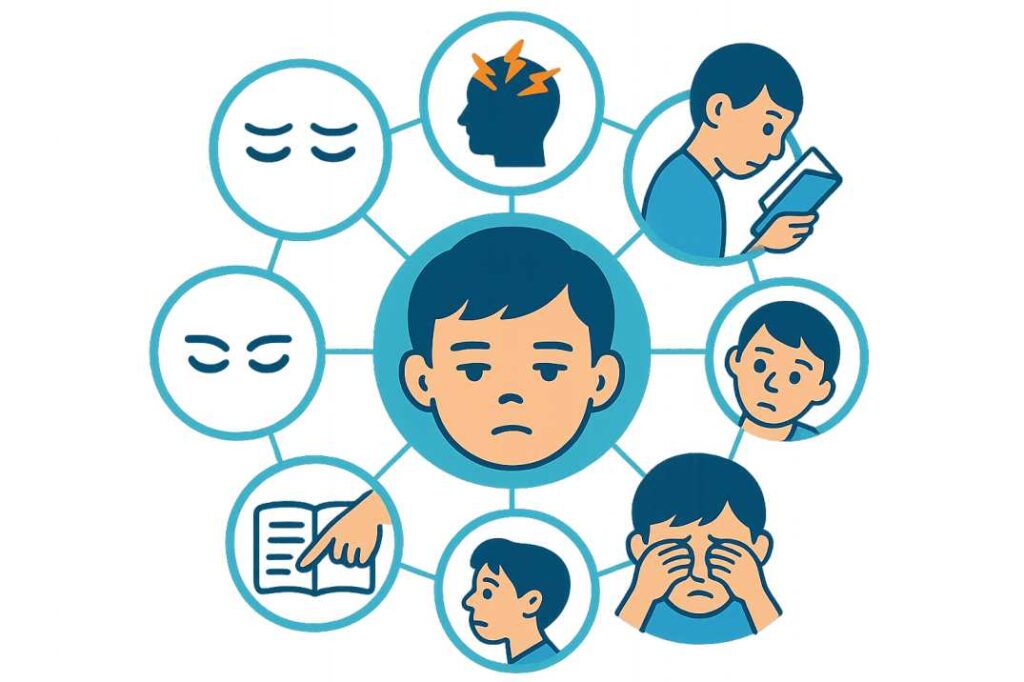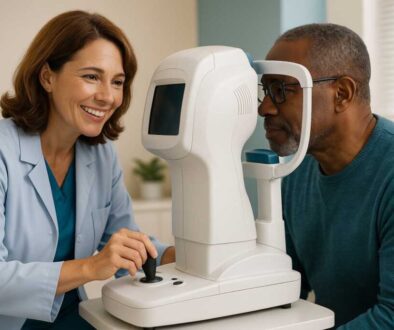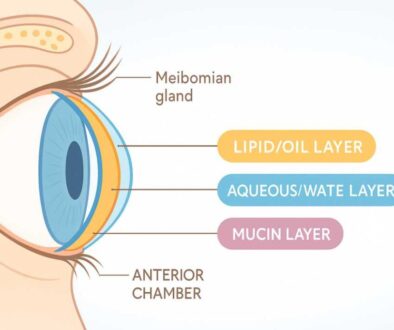Can Eye Problems Cause Learning Difficulties in Children?
Could Hidden Vision Problems Be Behind Your Child’s School Struggles?
One in four children (25%) has a vision problem significant enough to impact learning—yet many go undetected because they pass standard school screenings. The result? Bright children are mislabeled as “lazy” and fall behind when the real culprit may be a treatable vision problem.
If your child struggles academically despite their intelligence, understanding the vision-learning connection could change everything.
Why “20/20 Vision” Doesn’t Tell the Whole Story
When your child passes the school eye chart test, it only measures distance visual acuity. But learning requires complex visual skills working in harmony:
- Eye Teaming: Both eyes must work together to create a single, clear image
- Eye Tracking: Smooth, accurate movement across a page when reading
- Eye Focusing: Quickly shifting focus from near to far and maintaining clarity
- Visual Processing: The brain’s ability to interpret visual information
- Eye-Hand Coordination: Integration of visual input with motor skills
When any skill is compromised, learning becomes exponentially harder—even with perfect distance vision.
Research shows the impact: First-grade students who failed vision performance tests showed significantly lower academic scores (-0.49 vs. 0.22, P=0.04), demonstrating how subtle vision problems measurably affect learning.
Common Eye Problems Sabotaging Academic Performance
Convergence Insufficiency: The Hidden Problem
Affecting 5-13% of students, Convergence Insufficiency (CI) is highly treatable yet often undiagnosed. Children’s eyes struggle to turn inward and work together for near work, causing:
- Blurred or double vision when reading
- Words appearing to “float” on the page
- Frequent loss of place while reading
- Headaches and eye strain during homework
- Avoiding reading whenever possible
The ADHD Connection: Up to 15% of children with CI meet ADHD diagnostic criteria. The symptoms overlap dramatically, but treating vision problems often eliminates ADHD-like behaviors. The Convergence Insufficiency Treatment Trial showed 75% of children achieved improvement within 12 weeks using supervised vision therapy.
Eye Tracking Problems
About 30% of struggling readers have eye-tracking weakness. Symptoms include:
- Skipping lines or words when reading
- Using a finger to keep their place
- Tilting their head to read
- Reading fluency is well below grade level
- Poor comprehension despite strong verbal skills
Eye Teaming and Focusing Issues
Children with these problems experience blurry or double vision, making concentration impossible. They may describe words that “float” or “blur together.” What appears as an attention problem is actually a vision problem in disguise.
Warning Signs Every Parent Must Recognize
11 Critical Signs Your Child May Have Vision Problems:
- Avoidance of homework, especially reading
- Frequent headaches after school
- Short attention span during near work
- Reading below grade level
- Poor reading comprehension
- Homework is taking excessive time
- Copying difficulties from the board to paper
- Rubbing eyes, squinting, or closing one eye
- Losing place frequently while reading
- Persistent letter reversals beyond age 7
- Poor hand-eye coordination
Important: Many children don’t complain because they assume everyone sees the same way.
The ADHD-Vision Connection
Vision problems and ADHD share nearly identical symptoms:
- Difficulty sustaining attention during reading
- Makes careless mistakes
- Avoids tasks requiring mental effort
- Easily distracted during homework
- Fidgety during seated work
Key difference: Some children have ADHD alone, some have vision problems alone, and some have both. But vision problems are often easier to treat and can dramatically improve symptoms.
Before accepting an ADHD diagnosis or starting medication, ensure your child has had a comprehensive functional vision evaluation by a developmental optometrist—not just a basic screening.
Why School Screenings Miss These Problems
School screenings typically only test:
- Distance visual acuity (reading letters on a chart)
- Basic color vision
- Sometimes gross eye alignment
What they miss:
- Eye teaming and coordination
- Focusing ability at near distances
- Eye tracking skills
- Convergence ability
- Visual processing
- Sustained near vision comfort
A child can have 20/20 vision and still have significant vision problems affecting learning.
The Right Diagnosis: Comprehensive Evaluation
A thorough functional vision evaluation (45-90 minutes) includes:
- Visual acuity at multiple distances
- Binocular vision assessment
- Convergence testing
- Eye movement evaluation
- Focusing skills assessment
- Eye alignment testing
- Visual processing evaluation
- Symptom survey (CISS or similar)
Questions to ask your eye doctor:
- “Do you perform comprehensive binocular vision assessments for children with learning difficulties?”
- “Do you test for convergence insufficiency and other functional vision problems?”
- “Do you offer vision therapy if needed?”
Treatment Options That Work
When Glasses Help
Correcting refractive errors (nearsightedness, farsightedness, astigmatism) solves many problems quickly. However, glasses alone won’t fix functional vision skills like eye teaming, tracking, or focusing flexibility.
Vision Therapy: Evidence-Based Solution
Vision therapy is like physical therapy for the eyes and brain—a progressive program of procedures performed under a doctor’s supervision involving:
- Therapeutic lenses and prisms
- Specialized computer programs
- Eye tracking exercises
- Visual-motor integration activities
- Near-far focusing activities
The Evidence:
- 75% success rate for convergence insufficiency
- 12-week timeline for most improvements
- Permanent results when properly completed
- Academic improvement documented in research
Cost Considerations:
- Comprehensive evaluation: $150-$400
- Vision therapy per session: $125-$250
- Total program: $1,500-$9,000, depending on severity
- Many insurance plans provide coverage
- FSA/HSA accounts can be used
Taking Action: Your Step-by-Step Guide
Immediate Steps:
- Document symptoms – Keep a log of struggles (time of day, activities, physical complaints)
- Schedule comprehensive evaluation – Request functional vision testing, not just basic screening
- Communicate with teachers – Share concerns and request their observations
- Request accommodations – Front seating, extended time, vision breaks while awaiting evaluation
Building Your Support Team:
- Developmental optometrist for diagnosis and treatment
- Teachers for academic accommodations and monitoring
- Pediatrician for overall health coordination
- School counselor, if a comprehensive evaluation is needed
Real Results: A Success Story
Eight-year-old Jacob struggled with reading, had frequent headaches, and was falling behind. His teacher suggested ADHD. After a comprehensive vision evaluation revealed convergence insufficiency:
- Week 4: Headaches decreased
- Month 2: Reading without complaint
- Month 3: Teacher reported remarkable attention improvement
- Month 6: Reading at grade level and enjoying books
Early detection prevented permanent damage to his self-esteem and academic gaps.
Key Takeaways for Parents
- One in four children has a vision problem affecting learning, most of which are undetected
- Vision problems mimic ADHD and learning disabilities—rule out vision first
- Early detection is critical—every month of delay means lost academic ground
- Most problems are treatable—75% success rate for convergence insufficiency
- Trust your instincts—you know your child best
Scientific Research Supporting This Article
1. Tian, Y.J., et al. (2024) – Scientific Reports 14, 5879
First-grade students who failed vision tests showed significantly lower academic scores.
https://www.nature.com/articles/s41598-024-56548-7
2. Magakwe, T.S.S., et al. (2024) – F1000Research 13:1538
Vision problems affect social, emotional, and psychological domains beyond academics.
https://pmc.ncbi.nlm.nih.gov/articles/PMC11986411/
3. Loh, L., et al. (2023) – Journal of Optometry 17(2):100495
Systematic review confirms direct relationship between vision impairment and reduced reading performance.
https://pmc.ncbi.nlm.nih.gov/articles/PMC10641537/
Take the First Step Today
At West Broward Eyecare Associates in Tamarac, we specialize in comprehensive functional vision evaluations that go beyond basic eye charts. Our pediatric eye care experts have helped countless families discover and solve vision issues that hold children back.
Don’t wait another day. Every day of undiagnosed vision problems means:
- Academic frustration and falling further behind
- Damage to self-esteem and confidence
- Missing the joy of reading and learning
With proper diagnosis and treatment, your child can experience academic success that matches their intelligence.
Schedule your comprehensive evaluation today. We accept most insurance plans and offer flexible scheduling, including after-school appointments.
This article is for educational purposes and does not replace professional medical advice. Schedule a comprehensive eye examination with a qualified eye care professional.
West Broward Eyecare Associates – Serving Tamarac and Broward County with comprehensive family eye care, pediatric vision specialists, and vision therapy. Contact us today for your child’s evaluation.
FAQs
-
-
Vision issues make reading, tracking words, and focusing hard, leading to poor comprehension and classroom struggles.
-





